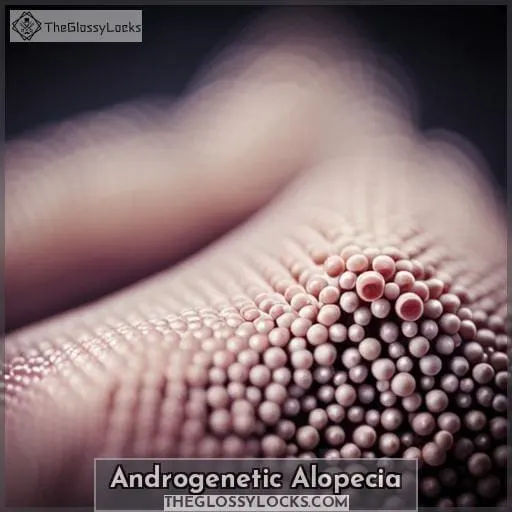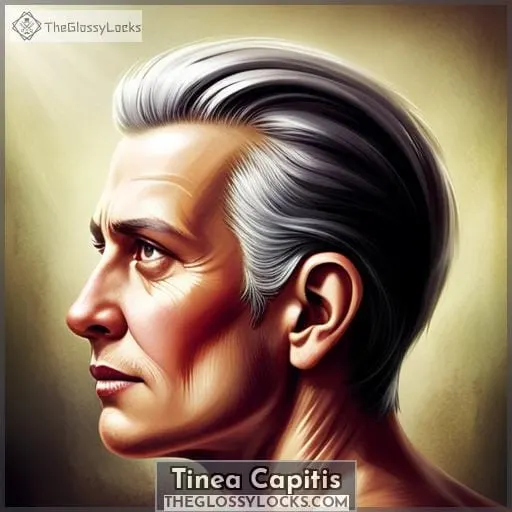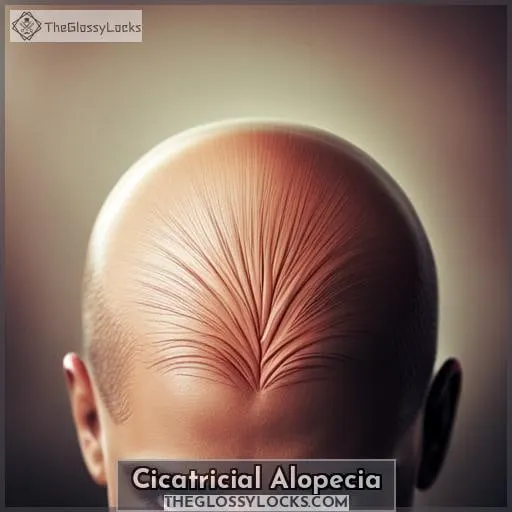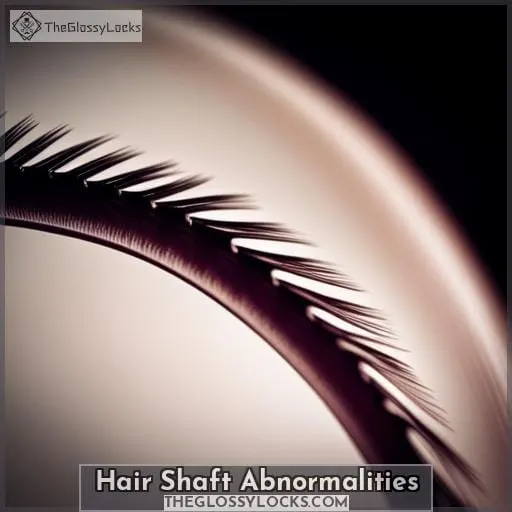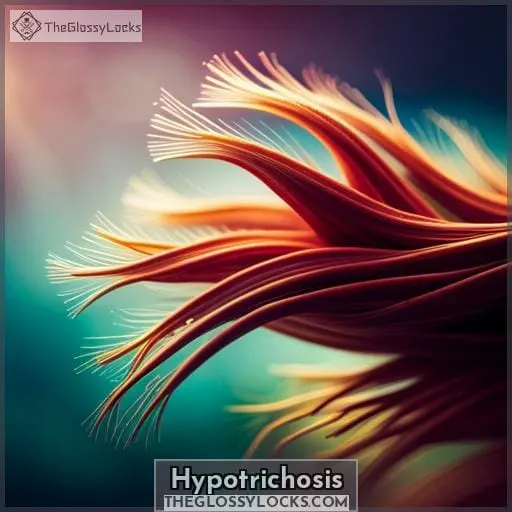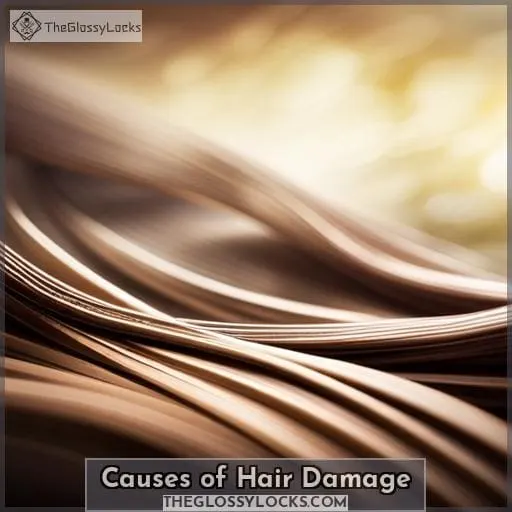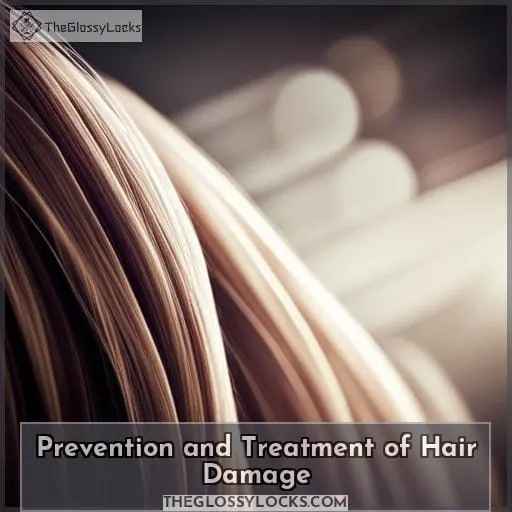This site is supported by our readers. We may earn a commission, at no cost to you, if you purchase through links.
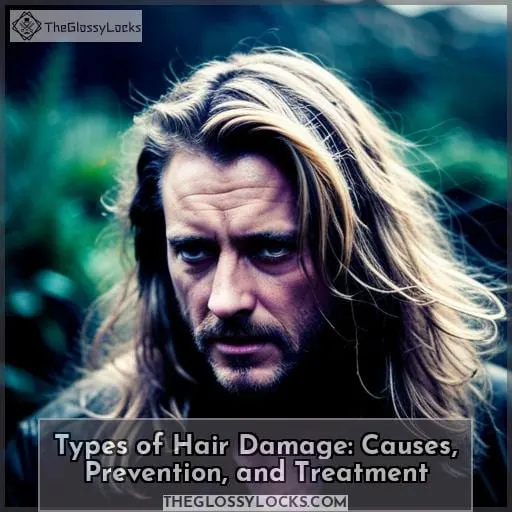 Are you suffering from hair damage? Don’t worry, you’re not alone. With over 50 million men and 30 million women in the United States experiencing some type of hair loss due to damaged follicles, it’s no wonder we’re all looking for ways to restore our tresses!
Are you suffering from hair damage? Don’t worry, you’re not alone. With over 50 million men and 30 million women in the United States experiencing some type of hair loss due to damaged follicles, it’s no wonder we’re all looking for ways to restore our tresses!
From alopecia areata and cicatricial alopecia to telogen effluvium and traction alopecia, there is a myriad of types of hair damage.
Here we’ll explore the common types of hair damage along with what can cause them as well as how best prevent or treat them so that your locks stay lusciously healthy!
Table Of Contents
Key Takeaways
- Androgenetic Alopecia, Telogen Effluvium, Alopecia Areata, and Tinea Capitis are common types of hair damage.
- Causes of hair damage include over-brushing, heat styling, towel-drying, lack of regular haircuts, poor diet, tight hairstyles, stress, and thyroid disorders.
- Hair damage can be prevented and treated by revamping hair care routine, using conditioner, reducing stress, and making dietary changes.
- Signs of hair damage include split ends, dryness, oiliness, thinning, and bald patches.
Androgenetic Alopecia
Androgenetic alopecia, also known as male and female pattern hair loss, is a common condition that affects millions of people. It occurs when the body produces hormones called androgens, which cause the follicles to become thin over time, resulting in decreased hair growth.
Male Pattern Hair Loss
Male pattern hair loss, or androgenetic alopecia, is a common type of hair disruption that affects millions. It typically follows the genetic patterns of male and female sufferers. Treatments can include medications to target hormonal factors or lifestyle impact, such as stress management.
Hair regrowth strategies may involve topical treatments to combat chemical damage from dyeing/bleaching, heat damage from styling tools, or other forms of hair shaft abnormalities. Nutritional supplements might be recommended for overall health benefits, which could help support healthy new growth as well as prevent further thinning.
All these elements are important when considering how best to tackle this issue in order to restore one’s self-confidence and wellbeing.
Female Pattern Hair Loss
Are you experiencing thinning hair and receding hairlines? Female pattern hair loss, or androgenetic alopecia, affects millions of women worldwide. The common causes are hormonal factors, lifestyle impact on the haircare routine, as well as damage from chemical treatments or heat styling.
Prevention is key: treat your scalp well with a balanced diet and regular trims to reduce split ends.
It’s important to understand the stages of hair growth when considering treatment. The growth phase, known as anagen, and the resting phase, known as telogen. A healthy approach for long-term success includes making changes in both behavior and products used in order to effectively manage female pattern baldness.
Telogen Effluvium
You may experience thinning or hair loss due to telogen effluvium, a disruption of the normal hair production cycle caused by medical events or medications. This type of alopecia can be triggered due to physical and emotional stress, crash diets, and certain medications such as anticoagulants and retinoids.
Common symptoms include diffuse shedding from all over the scalp that often leads to bald patches in severe cases.
To cope with this condition:
- Identify triggers: Track lifestyle changes leading up to your diagnosis for clues on what might have caused it.
- Hair growth support: Use treatments designed specifically for promoting healthy hair regrowth while taking medication if necessary under the doctor’s supervision.
- Stress management techniques: Meditation, yoga, and other relaxation activities can help reduce anxiety levels, which are known contributors to telogen effluvium flare-ups.
In addition, there is hope when it comes to treating Telogen Effluvium. Topical solutions like minoxidil, combined with tailored nutrition plans, can help nourish existing follicles while stimulating new ones into action so you don’t have to worry about permanent damage being done!
Anagen Effluvium
After discussing telogen effluvium, another type of hair loss to consider is anagen effluvium. This condition is caused by the interruption of the growth stage (anagen) and can be induced by chemotherapy or other medications.
Anagen effluvium often leads to extensive hair breakage and thinning across all areas of the scalp, although regrowth may occur in some cases after treatment has stopped.
There are few methods for preventing this type of hair loss, but avoiding harsh heat styling tools and using nourishing products with moisture-retaining properties can help reduce damage from environmental factors like sun exposure, which could trigger it.
Additionally, individuals undergoing chemotherapy should consult their medical team about possible treatments that could protect their existing locks from further damage during treatments, as well as aid in any potential regrowth afterwards.
Alopecia Areata
Alopecia areata is an autoimmune condition that causes patchy hair loss. It can be triggered by stress, genetic predisposition, and other factors. Hair regrowth strategies include topical treatments like corticosteroid injections or creams as well as natural remedies such as zinc supplements and essential oils.
Coping with alopecia involves managing its psychological impact through counseling or support groups within online communities of those who have experienced similar issues. Identifying damaged hair is key to preventing further thinning. Look for split ends, broken cuticles, dryness, or excess oiliness in the scalp area when assessing damage type(s).
Finally, it’s important to remember that you’re not alone on this journey—reach out for help if needed!
Tinea Capitis
Unlike alopecia areata, tinea capitis is a common scalp ringworm infection in children. It’s caused by fungus and can cause circular bald patches on the head with mild inflammation or redness. Treatment for this type of hair loss requires antifungal medications prescribed by your doctor to clear up the infection, as well as topical corticosteroids to reduce any inflammation or itching associated with it.
To manage tinea capitis infections, it is important to avoid tight hairstyles such as braids and ponytails that pull on the hair follicles. These can further irritate the scalp. Instead, use soft hypoallergenic fabric-covered elastic bands when styling your child’s hair.
This will prevent the scalp from being pulled too tightly while still keeping their hair looking nice.
If managing this condition becomes difficult over time, it is recommended to speak to a dermatologist about additional treatments. For more severe cases of childhood hair loss from fungal scalp infections, laser therapy may be an option.
Cicatricial Alopecia
Cicatricial alopecia, also known as scarring alopecia, is a type of hair damage resulting from conditions that destroy and replace the hair follicles with scar tissue. Lichen planopilaris is one such condition that affects both men and women of all ages, causing patchy baldness due to inflammation in the scalp.
Lichen Planopilaris
Discover how Lichen Planopilaris can cause scarring hair loss and other symptoms. Inflammation of the scalp is a hallmark of this condition, with treatment options to manage its effects on damaged hair.
Hair regrowth may be possible with underlying health conditions addressed, and fragile and unruly locks tamed through support groups or special treatments.
Discoid Lupus Erythematosus
Discoid Lupus Erythematosus is an autoimmune condition that causes scarring of the scalp and hair loss. It can manifest with skin lesions, sun damage, and scarring of the scalp. Treatment focuses on lupus management to reduce autoimmune effects.
Hair regrowth treatments are available, but results may vary from person to person depending on the severity of damaged hair caused by discoid lupus erythematosus.
Folliculitis Decalvans
Folliculitis Decalvans can cause lumps to form on your scalp, along with patches of hair loss. Maintaining good scalp hygiene is critical in treating this condition, as are treatment options such as antibiotics and topical steroids.
Managing symptoms should also be a priority, including a proper diet and stress reduction techniques. Hair loss from Folliculitis Decalvans may have an impact on daily life activities like exercise or social interactions, so it’s important to develop coping strategies for managing these issues.
Dissecting Cellulitis of the Scalp
You may experience a condition called dissecting cellulitis of the scalp, which can cause painful lumps and relentless hair loss. It’s an inflammatory form of cicatricial alopecia that often follows folliculitis decalvans.
Symptoms include itching, redness, burning sensations on the scalp, swelling, and scabbing.
Treatment options range from topical steroids to oral antibiotics. However, underlying causes like split ends or hard water damage must also be addressed for long-term success in managing symptoms.
Patients share experiences with their journeys to find relief from this condition – some finding freedom while others continue their search for solutions such as frontal fibrosing alopecia or traction alopecia treatments.
Frontal Fibrosing Alopecia
Frontal fibrosing alopecia is an autoimmune disorder that causes hair loss and scarring in postmenopausal women, with a unique pattern of receding temples. Treatments include dietary changes, reducing stress levels, avoiding tight hairstyles, and addressing underlying thyroid disorders.
Hair care products should be specially designed for frontal fibrosing alopecia to reduce inflammation and promote regrowth. Styling choices can help those coping emotionally with the effects of hair loss, such as wearing wigs or turbans if desired.
Research into the condition continues to uncover new insights into potential treatments like topical immunotherapy drugs, which are being studied currently.
Hair Shaft Abnormalities
You may be familiar with the common types of hair damage, but there are a few lesser-known causes of hair loss and changes in texture. Loose Anagen Syndrome is a condition that primarily affects young children, causing their hairs to become easily detached from the scalp.
Trichotillomania is an impulse-control disorder where individuals pull out their own hair due to psychological distress or as a nervous habit. Traction Alopecia occurs when tight hairstyles like braids place too much tension on the follicles, leading to thinning or balding patches over time.
Loose Anagen Syndrome
Discover how loose anagen syndrome, a rare condition in children that causes easily falling hair, can disrupt the natural cycle of hair production. To help maintain healthy-looking locks: shampoo and condition properly; lightly towel dry with care; avoid excessive styling tools or heat applications; take special precautions when brushing to prevent breakage; and use products tailored for specific hair texture.
Trichotillomania
Trichotillomania is an impulse control disorder that causes people to pull out their own hair, resulting in patchy hair loss. Coping strategies can include wearing a hat or wig. Regular haircuts may help the regrowth process.
Support groups provide much-needed emotional support, as well as possible treatments for underlying issues such as eating disorders, which can be related to this condition. Hair regrowth treatments, such as minoxidil and laser therapy, may help with male pattern hair loss or central centrifugal cicatricial alopecia associated with trichotillomania.
However, dull and rough hairs remain even after successful treatment of the disorder.
Traction Alopecia
Traction alopecia is caused by hairstyles that pull too tightly on the scalp, leading to permanent hair loss. To prevent it from happening, choose loose styles and avoid tight braids or ponytails. Treatment includes medicated creams and shampoos, corticosteroid injections, and in some cases, surgery may be necessary.
For those with traction alopecia in children due to cornrows or headbands worn for long periods of time, it is important to consult a medical professional as soon as possible for proper treatment options.
In order to reduce occurrences of traction alopecia overall, it’s important to be conscious about your hairstyling choices when planning out new looks.
Hypotrichosis
Unbelievably, Hypotrichosis is a rare genetic condition that results in sparse hair! Its causes include mutations of certain genes, which can affect the structure and function of proteins responsible for healthy hair growth.
Treatment options vary depending on severity; however, many focus on coping strategies to manage stress and anxiety associated with this condition.
Hair restoration may be possible through medications or even surgery but should only be considered after consulting a doctor or specialist first.
- Causes: Mutations of certain genes affecting protein structures & functions.
- Treatments: Coping strategies to manage stress & anxiety; Medications or Surgery (consultation required).
- Genetic Factors: Could potentially pass it down from mother/father’s side if they have it too.
- Hair Restoration Possibility: Depending on severity could restore fullness with medication/surgery – consult doctor first though!
With appropriate treatment plans plus lifestyle changes like avoiding tight hairstyles and using heat protectants when styling tools are used, individuals living with Hypotrichosis can live life confidently despite their thinning hair issue.
Causes of Hair Damage
You may be damaging your hair without realizing it. Over-brushing, using heat styling tools, towel-drying too harshly, skipping regular haircuts and trims, not getting adequate nutrition in the diet, wearing tight hairstyles for prolonged periods of time, and high levels of stress can all cause damage to the hair shafts.
Over-brushing
Over-brushing damages strands and the scalp. Gentle detangling and brushing techniques, as well as hair health products, are vital for repair.
Heat and Lack of Moisture
Heat, lack of moisture: dry, brittle hair; high heat + no protectant = damage. Maintaining moisture balance is key to prevent breakage. Heat protection and frizz control are crucial for lasting styling without damage.
Towel Drying
Towel-drying: Gentle technique. Hair towel options, post-shower care. Myths debunked; avoid breakage and damage!
Not Having Regular Haircuts
Not getting regular haircuts can cause split ends and breakage, leading to weakened strands that require extra care:
- Split ends lead to frizz control issues.
- Trimming benefits include less styling time between salon visits.
- Haircare is improved when frequent haircuts are part of the routine; it promotes hair health overall!
- Styling tips, such as using heat protectants, help reduce the damaging effects of heated tools on hair length and texture over time too!
- Regular maintenance helps keep your locks looking healthy, fresh, and vibrant for longer periods of time in-between trims or cuts at the salon!
Diet
Maintaining balanced nutrition helps hair health. Nutrient balance, dietary choices, and nutritional impact are key.
Tight Hairstyles
Avoid tight hairstyles, which can cause mechanical damage to hair. Braid damage from tugging on hairs; scalp tension from elastic banding; breakage due to overtightening. Poor scalp health results in weakened strands and damaged roots. Regular trims help restore strength and reduce shedding.
Stress
Although stress is often overlooked, it can cause up to 20% of hair loss cases. It’s important to recognize the signs and take steps towards reducing stress for healthy hair. Coping with stress through mindfulness, exercise, or talking about issues can help reduce its damaging effects on one’s locks.
Thyroid Disorders
Thyroid disorders severely affect hair health, causing issues such as loss, thinning, color damage, and split ends. Treatments for these disorders include medication and lifestyle changes. To manage these issues effectively, it is important to balance hormones.
This can be done through options like hypothyroidism supplements or scalp massage therapy.
Uncontrolled thyroid disorders disrupt the hair production cycle, leading to hair loss and other types of damage. This includes thinning strands, discoloration from chemical treatments, split ends from heat styling tools, and mechanical trauma from tight hairstyles or rough brushing habits.
These issues are all consequences of hormone imbalances associated with thyroid conditions.
To address these problems, there are several approaches that can be taken. First, medication such as levothyroxine may be prescribed by a doctor to regulate thyroid hormone levels. Alternative therapies like acupuncture have also been found effective in managing symptoms related to an underactive glandular system.
Understanding the connection between thyroid disorders and hair loss is crucial when seeking solutions for overall health improvement. Additionally, managing hair issues with thyroid disorders can be done by using products specifically designed for those with hypo/hyperthyroidism.
For individuals with hypothyroidism and hair thinning, using dietary supplements tailored towards supporting healthy thyroids could help reduce potential risks linked to nutrient deficiencies caused by low functioning glands.
Lastly, scalp massage therapy, an ancient technique often used alongside medications, has been proven beneficial not only in providing relaxation but also in stimulating hair growth.
Eating Disorders
Eating disorders ravage health, causing hair loss. Nutritional imbalances, psychological effects, and body image issues all contribute. Recovery strategies include medical interventions and lifestyle changes to improve well-being.
Prevention and Treatment of Hair Damage
It’s important to be proactive when it comes to preventing and treating hair damage. To keep your locks looking healthy, you should consider changing up your hair care routine, using a conditioner regularly, reducing stress levels as much as possible, and making dietary changes.
Change Haircare Routine
To protect your hair from damage, consider revamping your hair care routine, just like you would freshen up a tired wardrobe. Invest in quality hair care products tailored to your particular hair type and season-specific needs.
Incorporate natural remedies, such as deep conditioning masks with essential oils, for added nourishment.
Use a Conditioner
Transform your hair with a high-quality conditioner that repairs and nourishes damaged strands for smooth, healthy locks. Its benefits include improved hydration to prevent frizz, enhanced strength and flexibility, plus a long-lasting moisture lock.
Incorporate it into your hair care routine for sleekness while protecting against future damage.
Reduce Stress
Reducing stress is key to healthy hair. Relaxation techniques, mindfulness practices, and lifestyle adjustments can help prevent damage and restore strength from within. Stress management is important to avoid common issues like thinning or breakage due to excessive worrying.
Take time each day for yourself: practice yoga or meditation, listen to music you love – anything that helps you escape the daily grind and be present in the moment.
Dietary Changes
By incorporating dietary changes, you can help protect your hair from damage and create an environment for healthy growth. Nutrition impact, dietary choices, food for hair – focus on a nutrient-rich diet to maximize your hair health.
Eat foods containing biotin, zinc, and iron; add fatty acids such as Omega 3s found in salmon; consume leafy greens like kale or spinach for vitamin A and C; drink plenty of water to hydrate follicles.
Conclusion
It’s estimated that up to 50% of people suffer from some type of hair damage, whether it’s from genetics, styling, or environmental factors.
No matter the cause, it’s important to be aware of the different types of hair damage and how to prevent and treat them.
From androgenetic alopecia and telogen effluvium to alopecia areata and hypotrichosis, there is a range of conditions that can affect the health of our hair.
To protect and preserve our hair, we should be mindful of our daily hair care routine. This includes reducing heat and styling, avoiding tight hairstyles, and regularly moisturizing and conditioning.
With the right knowledge and care, we can maintain healthy, beautiful hair.

